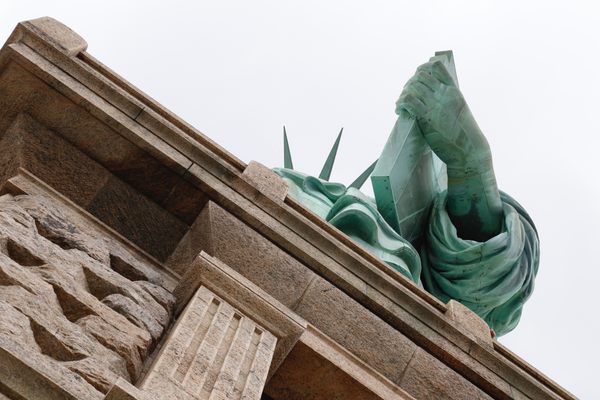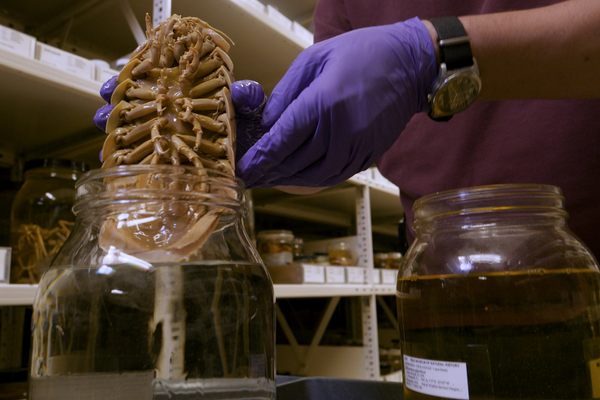The Bizarre True Story of Central Park’s Doomed Victorian Dinosaur Museum
For centuries, the infamous Boss Tweed was blamed for destroying its dino-models—but what really happened is even weirder.
There are dinosaurs buried beneath New York City’s Central Park. Now these aren’t your typical T. rex or Triceratops left behind in layers of sediment. These dinosaurs aren’t millions of years old and never took a gulp of air. They’re dapper Victorians, made of cement, wire, stone, and clay. They were entertainers and educators, meant to give New Yorkers their first glimpse of the prehistoric creatures that once roamed New Jersey forests and Connecticut lakeshores. But in 1871, these carefully crafted, life-size models were destroyed, smashed into worthless smithereens, and then buried in a small mound in Central Park. According to historian Vicky Coules of the University of Bristol, the event remains the “greatest act of vandalism in the history of dinosaur study and museum development.”
For more than a century, the villain behind the destruction was thought to be William Magear Tweed, a corrupt Tammany Hall politician better known as Boss Tweed, who controlled New York City with his “Tweed ring” cronies. But after almost a year of combing through government and newspaper archives, Coules discovered that the real villain wasn’t Tweed at all, but Henry Hilton, a New York lawyer who was appointed to oversee the city’s parks. And the more Coules dug into the story, the stranger it became. Hilton, she says, “did other things that were just bizarre.”
In the mid-19th century, very few people knew about dinosaurs; the word “dinosaur” had only been coined in the early 1840s. But English sculptor and natural history artist Benjamin Waterhouse Hawkins set out to change that. In 1851, Hawkins created dozens of life-sized, scientifically accurate (at least for the time) dinosaur models in a South London park: the famous Crystal Palace dinosaur display. When they were unveiled, Hawkins’s dinosaurs were a sensation; on opening day, 40,000 visitors flocked to the park. As paleontologist Thomas Holtz of the University of Maryland puts it, Hawkins “is the real start of the popularization of dinosaurs.”
In 1868, Hawkins was commissioned to complete an even more ambitious dinosaur replica project in New York City. He was tasked with creating the show stopping models for the country’s first-ever dinosaur museum, the Paleozoic Museum.

Housed beneath a massive arched roof, the Paleozoic Museum would display models of North America’s prehistoric creatures, from the recently discovered Hadrosaurus, a massive duck-billed Cretaceous herbivore, to a giant Ice Age deer, Cervalces scotti, which would’ve towered over a modern elk.
As part of his research, Hawkins traveled to Drexel University’s Academy of Natural Sciences (ANSP) in Philadelphia. In exchange for the ANSP’s help with his research, Hawkins volunteered to mount the museum’s Hadrosaurus skeleton. It was the first time in history that a dinosaur skeleton was mounted in a life-like position (at least the tail-dragging posture presumed to be accurate at the time). “And that’s when everybody went crazy,” says Coules. It was the United States’ first taste of “dino mania.”
When the academy unveiled its standing skeletal Hadrosaurus, more than 100,000 visitors streamed in to see it, “almost twice as many as had visited the museum the previous year,” said Robert Peck, a ANSP curator and author of All In The Bones: A Biography of Benjamin Waterhouse Hawkins, via email. “No one had ever seen a dinosaur skeleton before. They were awed by both its size and its novelty,” said Peck.
For the first time, people were realizing just how weird and alien dinosaurs were. “There’s nothing around today that’s like a Triceratops or a Tyrannosaurus,” says Holtz. When you see a dino skeleton towering over you, he adds, “It’s almost as if they’re dragons come to life.”
Fresh off his success at the ANSP, Hawkins returned to New York and got busy modeling his dinosaurs for the Paleozoic Museum. Sketches of Hawkins’s in-progress dinosaur models were featured in newspapers, and the public eagerly awaited the museum’s opening. But almost from the beginning, the Paleozoic Museum was plagued with setbacks.

In May 1870, Boss Tweed fired the administrative leaders of Central Park who had hired Hawkins and replaced them with two of his underlings, including one very peculiar lawyer named Henry Hilton. Hilton, says Coules, “was a very strange, very arrogant man,” who seemed to be obsessed with painting things white. In one incident, he ordered a bronze Central Park statue of Eve to be painted white, badly damaging the statue. On another occasion, Hilton whitewashed a whale skeleton that had been given to the American Museum of Natural History, which was still under construction at the time. The paint damaged the whale skeleton so badly that it was beyond restoration.
Soon after Hilton’s appointment as Central Park treasurer, he canceled the Paleozoic Museum, leaving Hawkins upset and without a job. A few months later, Hilton, seemingly unprompted, ordered the destruction of Hawkins’s models, which still hadn’t been paid for. In the minutes from that particular May 1871 meeting, the order sounds like a simple tidying-up: “The old barn, shed, and structures at that place [are to] be removed under the direction of the Treasurer.”
The following day, Hawkins’s revolutionary models were smashed into worthless bits and buried somewhere in Central Park. Hawkins never attempted another large-scale exhibit and died, back in England, in 1894, “a bit of a lowkey sad ending” for the man to bring dinosaurs to the public, says Coules.
If they had survived, Hawkins’s models “would have been wonderful examples of early thinking about dinosaurs and other prehistoric creatures,” said Peck. Just like his Crystal Palace Dinosaurs, they would have been “hugely popular to modern day audiences.”
As the decades wore on, more fossils, many unearthed during the “Bone Wars” of the late 19th century, led to scientific discoveries about dinosaurs that would have made Hawkins’s replicas seem quaint and inaccurate had they endured. But that wouldn’t have made Hawkins’s models any less important. “Science is a process,” says Holtz, and it’s important to remember how one discovery builds upon another.

Less than a century later, Hilton’s central role in the destruction of Hawkins’s dinosaurs disappears from mentions of the event, and Boss Tweed is instead saddled with the blame. It’s something Kenneth Ackerman, author of Boss Tweed: The Corrupt Pol Who Conceived the Soul of Modern New York, doesn’t find surprising. “It was easy to blame things on Boss Tweed. Tweed made a convenient villain,” he said via email, and “much of the later vilification of Tweed had self-serving motives.” One reporter, with no cited sources, claimed that Tweed found the idea of dinosaurs blasphemous and therefore destroyed the models, but there is no evidence Tweed felt such convictions. “Tweed, a pragmatist, never cared much about academic or religious issues like this,” said Ackerman.
The story behind the ill-fated Paleozoic Museum has been told before—we even wrote a story about it back in 2015. But Coules’s new piece of the puzzle—that Hilton, and not Tweed, is to blame for the destruction of Hawkins’s models—reveals something important about the way we record history. While sifting through accounts of what happened to Central Park’s dinosaur museum, Coules saw that history books and articles were citing and re-citing each other, cementing the inaccuracy into place. “We see it all the time in history, don’t we? Where a story gets sort of propagated? And then when you actually get to the bottom of it, you find that’s not what happened after all.” It’s always “worth having a little dose of healthy skepticism about things,” she says.
As for the final resting place of Hawkins’s dinosaurs, it’s unclear, says Coules. According to Gothamist, the sledge-hammered remains were allegedly dumped into Central Park’s Pond near the park’s southeastern corner. But, despite numerous dredgings of the pond, none of Hawkins’s dino bits have ever been uncovered. Perhaps the smashed remains of dapper Victorian dinosaurs will be unearthed centuries from now, leaving their finders to scratch their heads and wonder, like the early paleontologists did about real dinosaur bones, what on earth they are.














































Follow us on Twitter to get the latest on the world's hidden wonders.
Like us on Facebook to get the latest on the world's hidden wonders.
Follow us on Twitter Like us on Facebook